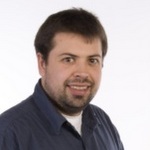
Richard Abel
SSI fellow
Imperial College London
Interests
Richie is primarily interested in developing 3D imaging techniques, such as CT and MRI for diagnosing metabolic bones disease, as well as monitoring treatment outcomes.
Research
Many scientists are concerned with characterising both the size and geometry of objects and organisms, particularly the internal structure or composition. For example the internal architecture of bones, thickness and shape of cartilage in human joints, fluid low around blood circulatory systems or porosity of oil-bearing rocks. All of these studies require that object or organism under investigation not be damaged.
Richie is an expert in Micro-Computed Tomographic (CT) scanning. Micro-CT is a non-destructive radiographic imaging technique that produces 3D models of an object or tissue on a computer based on density distribution, as measured by X-ray transmission. The resulting 3D volumes can be used to create ‘virtual’ computerised models of specimens that can be manipulated, sectioned, prepared, dissected and measured as though in the hand, but – unlike handheld specimens - with internal as well as external morphology. This allows access to the morphological information contained inside fragile, rare, valuable or small specimens.
Richie largely applies micro-CT to understand the structure and function of bone, particularly in humans. The research is question driven but entirely dependent on computer software for reconstructing, processing and rendering CT models in three-dimensions. In order to carry out these tasks Richie uses many free software packages written by scientists, such as BoneJ, Quant3D and SPIERS. As well as in software developed in house, such as PhaseQunat and Acrobot Planner. As such Richie is very concerned with the sustainability of the software packages and, more importantly, future software developments for better processing and measuring 3D CT computer models.
Check out contributions by and mentions of Richard Abel on www.software.ac.uk
